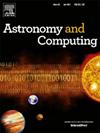下一代天文台开放科学平台中的三维无线电数据可视化
IF 1.8
4区 物理与天体物理
Q2 ASTRONOMY & ASTROPHYSICS
引用次数: 0
摘要
下一代望远镜将带来突破性的发现,但也会带来新的技术挑战。平方公里阵列天文台(SKAO)将是最苛刻的科学基础设施之一,预计每年700 PB的数据输出将分配到SKA区域中心网络。目前的工具并不完全适合管理如此庞大的数据量,因此,需要新的研究将科学档案从数据提供者转变为服务提供者。在本文中,我们研究了科学档案如何为SKA科学档案提供高级可视化功能。特别是,我们对现有的天文学和其他领域的可视化软件进行了彻底的探索,以确定能够满足大数据需求的工具。使用选定的技术,我们开发了一个原型档案,通过基于网络的界面提供对3D无线电数据的交互式可视化访问,坚持国际虚拟天文台联盟(IVOA)的建议,以支持互操作性和开放科学实践。此外,我们还讨论了当前IVOA的建议如何支持这些可视化功能,以及如何扩展这些功能。我们的原型存档包括一项服务,以动态生成3D模型作为服务器操作,以灵活的方式实现远程可视化;例如,可以使用一组参数来定制模型及其可视化。我们使用SKA前体和探路者数据来测试其可用性和可扩展性,得出结论认为远程可视化是处理大容量数据的可行解决方案。然而,我们的原型受到内存限制的限制,需要减少内存使用的技术。本文章由计算机程序翻译,如有差异,请以英文原文为准。
3D radio data visualisation in open science platforms for next-generation observatories
Next-generation telescopes will bring groundbreaking discoveries but they will also present new technological challenges. The Square Kilometre Array Observatory (SKAO) will be one of the most demanding scientific infrastructures, with a projected data output of 700 PB per year to be distributed to a network of SKA Regional Centres. Current tools are not fully suited to manage such massive data volumes, therefore, new research is required to transform science archives from data providers into service providers. In this paper we examine how a science archive can deliver advanced visualisation capabilities for the SKA science archive. In particular, we have conducted a thorough exploration of existing visualisation software for astronomy and other fields to identify tools capable of addressing Big Data requirements. Using selected technologies, we have developed a prototype archive that provides access to interactive visualisations of 3D radio data through web-based interfaces, adhering to International Virtual Observatory Alliance (IVOA) recommendations to favour interoperability and Open Science practices. In addition, we discuss how current IVOA recommendations support these visualisation capabilities and how they could be expanded. Our prototype archive includes a service to generate 3D models on the fly as a server operation, enabling remote visualisations in a flexible manner; for instance, a set of parameters can be used to customise the models and their visualisation. We have used SKA precursor and pathfinder data to test its usability and scalability, concluding that remote visualisation is a viable solution for handling high-volume data. However, our prototype is constrained by memory limitations, requiring techniques to reduce memory usage.
求助全文
通过发布文献求助,成功后即可免费获取论文全文。
去求助
来源期刊

Astronomy and Computing
ASTRONOMY & ASTROPHYSICSCOMPUTER SCIENCE,-COMPUTER SCIENCE, INTERDISCIPLINARY APPLICATIONS
CiteScore
4.10
自引率
8.00%
发文量
67
期刊介绍:
Astronomy and Computing is a peer-reviewed journal that focuses on the broad area between astronomy, computer science and information technology. The journal aims to publish the work of scientists and (software) engineers in all aspects of astronomical computing, including the collection, analysis, reduction, visualisation, preservation and dissemination of data, and the development of astronomical software and simulations. The journal covers applications for academic computer science techniques to astronomy, as well as novel applications of information technologies within astronomy.
 求助内容:
求助内容: 应助结果提醒方式:
应助结果提醒方式:


